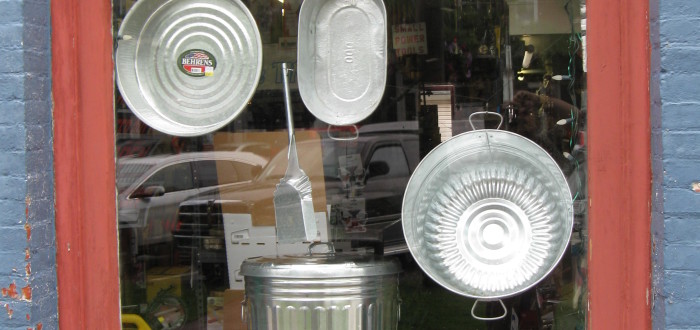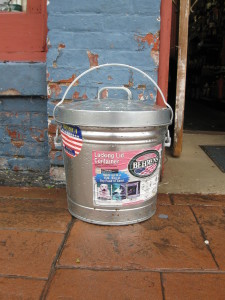When we went to decorate the store window this week, my wife came up with the idea of putting some of our “tinware” on display. I thought it was a great idea as it is one of the more unique products that we offer at the store. I love tinware and I’ve always preferred metal buckets, washtubs and garbage cans to their plastic imitations. They are much stronger, last longer and have a great patina that plastic just can’t match. But first, a disclaimer, most “tinware” isn’t tin! Tinware, or more correctly “galvanized sheet goods” (doesn’t quite roll off the tongue the same way), is actually steel underneath. This makes it strong, but if left untreated it will rust very quickly. Long ago processes were developed to keep the steel from rusting and several are still used today.
Actual tin “tinware” is made from tin plated steel. The steel sheets are coated with tin before fabrication, and the resulting articles are very corrosion resistant. Real tin is very expensive and is used only for food contact items (think tin cans), as other types of plating can be toxic.
Common “tinware” is coated with zinc. The zinc resists corrosion very well. When first produced, the item is very shiny, but as it ages in the weather it turns gray to grayish-white as the zinc coating slowly corrodes away. The steel underneath will not begin to rust until the zinc is all but gone, giving it a much longer life. The thicker the zinc coating the longer the item will last. There are two ways to coat steel with zinc, one is to coat the sheet first, and then make the object, the other is to make the object and the coat it. The first way consists of running the sheet steel though a chemical plating bath and passing electricity through it to plate the zinc onto the steel. Hence it’s name – electrogalvanized. This produces a thin smooth coating good for items that will be exposed to water, but not continuously wet. Garbage cans are a good example. The second way is to make the entire product first, and the dip it in molten zinc. This, appropriately enough produces “hot dipped” items. Hot dipping produces a much thicker, somewhat rough zinc coating on the steel, it also seals the joints and makes the product water tight. Hot dipping is used for pails, watering troughs and the like, that will actually be full of water for much of their lives.
Tinware is more costly than most plastic, but will usually long outlast it. I’m still using some of my mom’s garden buckets, and my first metal garbage cans lasted over ten years and I kept them outside. You can also beat them back into shape after you run into them with the car (don’t ask me how I know this). And when they have lived out their long life, you can take them to the scrap yard, and they can be recycled into something else. So next time that you’re tempted to buy a cheap plastic bucket, think long-term and buy some tinware, it’s available here, at the old hardware store.


